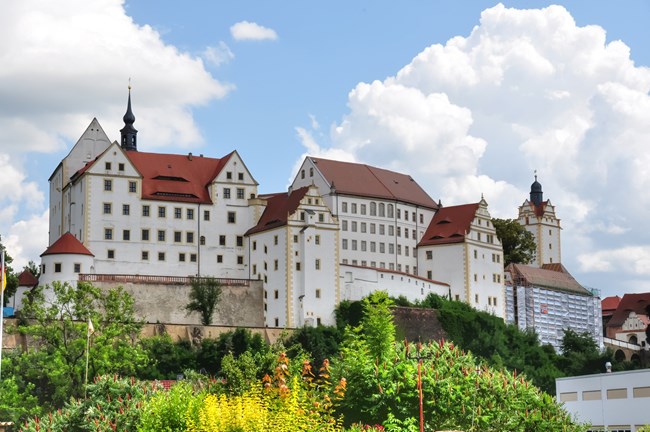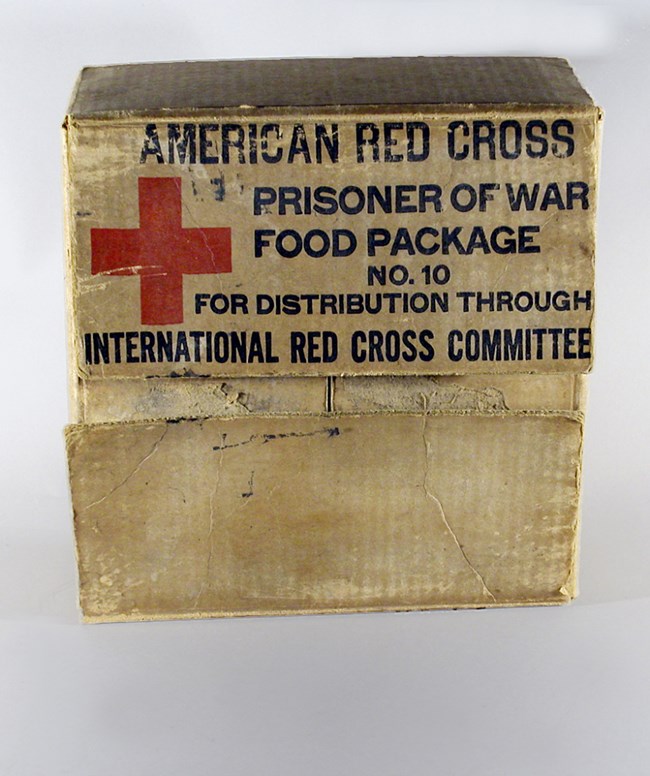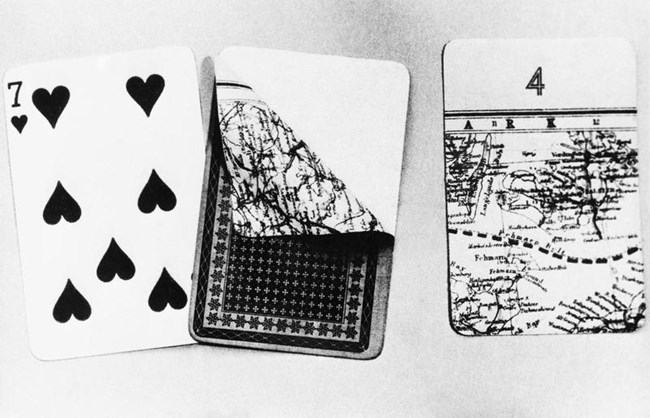Last updated: June 23, 2023
Article
Stacking the Deck: Escape Cards of World War II
During World War II, American and British intelligence agencies collaborated on a top-secret mission with the US Playing Card Company. To help Allied prisoners of war escape from Nazi prison camps, the company devised a way to hide a map of Germany inside playing cards.

Photo by Lowgoz, Wikimedia Commons, Attribution-ShareAlike 3.0 Unported (CC BY-SA 3.0)
Detained at Colditz Castle
During World War II, Nazi Germany captured and detained nearly 94,000 prisoners of war (POWs) from the United States.[1] POWs from the US and other Allied nations were imprisoned at Prisoner of War Camps throughout Europe, including Stalag Luft III in western Poland and Oflag IV-C in eastern Germany.
In 1939, the Nazis established Oflag IV-C near Leipzig. They converted the Renaissance-style Colditz Castle into a prisoner of war camp. Colditz Castle was primarily used for detaining captured Allied officers, especially those who were high-profile or likely to escape.[2] Oflag IV-C had a reputation for being impossible to escape. It was the only Nazi prison camp where guards outnumbered prisoners. The castle was itself built on a high, rocky hill, 400 miles from the closest Allied forces.

Smithsonian Institution National Museum of American History. Usage conditions apply.
The camp’s escape-proof reputation did not deter Allied prisoners. Some dug tunnels into the floors or through the castle’s thick stone walls, while others plotted different ways to break out. Although the exact number varies, there were at least 130 escape attempts from Colditz Castle. Only 32 succeeded. In April 1945, the US Army captured Colditz Castle and liberated the remaining Allied POWs.
Help from the Home Front
To facilitate escape attempts, the American Office of Strategic Services (precursor to the CIA) and British Special Operations Executive hatched a plan. They tasked the United States Playing Card Company (USPCC) to create decks of Bicycle brand playing cards that could conceal maps of Germany.[3]
Under the rules of the Geneva Conventions, the Red Cross and other charitable organizations could send parcels and mail to prisoners of war.[4] In addition to clothing, food, medical supplies, and tobacco, parcels could contain games, such as playing cards. If Allied POWs were lucky, an enclosed deck of cards would offer more than just a way to keep busy.

Courtesy of the Imperial War Museum © IWM HU 58537
All Bicycle decks had the same white and blue design, but a crooked cellophane seal on the box indicated that there was more than met the eye. When the cards were wet, POWs could peel apart the layers of paper, revealing pieces of a large map. Once the cards were arranged in order, the map outlined escape routes out of Germany.[5] Other cards contained instructions about places to avoid or landmarks to look out for.
Based in Norwood, Ohio (an enclave of Cincinnati), the US Playing Card Company Complex had already converted much of its production lines to wartime uses. The company churned out parachutes for antipersonnel fragmentation bombs.[6] Other products included materials for defense, as well as electronics and radar devices for the Navy and Signal Corps. During World War II, the USPCC produced another special deck of cards printed with the shapes of military vehicles from other warring countries. Known as “spotter decks,” these cards were intended to help civilians identify ships, tanks, and aircraft from both friendly and enemy nations.

Photo by Nytted, Wikimedia Commons, public domain
Legacy
Due to the top-secret nature of the map decks, the project had to remain confidential for many years after the war. It is unknown how many escape map decks were produced or survived. Only two full decks are still known to exist. They are both held in the collection of the International Spy Museum in Washington, DC.
To recognize its contribution to the war effort, the US Playing Card Company released a commemorative escape map deck in 2013. Unlike the original, the commemorative deck openly displays sections of the map on the front of each card.
In 2009, the USPCC relocated to a smaller facility in Erlanger, Kentucky. The US Playing Card Company Complex in Norwood, Ohio was listed in the National Register of Historic Places in 2015.
This article was researched and written by Jade Ryerson, Cultural Resources Office of Interpretation and Education.
[1] Gary K. Reynolds, “WWII - US POWs and Civilian Internees,” in US Prisoners of War and Civilian American Citizens Captured and Interned by Japan in World War II: The Issue of Compensation by Japan, Congressional Research Service Report for Congress, updated December 17, 2002, https://www.history.navy.mil/research/library/online-reading-room/title-list-alphabetically/u/us-prisoners-war-civilian-american-citizens-captured.html.
[2] Prisoners included officers from Poland, France, the Netherlands, Great Britain, and the US.
[3] Escape map decks were just one of many top-secret methods that American military intelligence used to help American servicemen to evade and escape capture. To learn more, check out this article about POWs and Intel at Fort Hunt.
[4] The Geneva Conventions are a series of four treaties that established international legal standards for humanitarian treatment during wartime. They describe the rights of military personnel, prisoners of war, and civilians. They also describe protections for sick and wounded soldiers.
[5] The joker cards included instructions explaining that the intended order of the cards was spades, diamonds, clubs, and hearts.
[6] When they exploded, antipersonnel fragmentation bombs released shot or other fragments that could be deadly when released at a high velocity.
Editors of the Encyclopaedia Brittanica. “Colditz Castle.” Encyclopedia Britannica. April 26, 2017. https://www.britannica.com/topic/Colditz-Castle.
Fry, Helen. “Great Escapes.” Chap. 7 in MI9: A History of the Secret Service for Escape and Evasion in World War Two, 119-136. New Haven: Yale University Press, 2020. https://www.jstor.org/stable/j.ctv15pjxb4.15.
Kochavi, Arieh J. “Washington and American POWs.” Chap. 3 in Confronting Captivity: Britain and the United States and Their POWs in Nazi Germany, 71-102. Chapel Hill: University of North Carolina Press, 2014.
Naylor, Wendy and Diana Wellman. “United States Playing Card Company Complex.” National Register of Historic Places Registration Form. Naylor Wellman, LLC, Cleveland Heights, June 30, 2015. https://npgallery.nps.gov/GetAsset/5e810d3c-e633-4cd6-9bfe-49402ec65ec9.
Newcomb, Tim. “In 1944, U.S. POWS Got the Best X-Mas Gift of All—An Escape Map.” Popular Mechanics. December 24, 2020.
Reynolds, Gary K. “WWII - US POWs and Civilian Internees.” In US Prisoners of War and Civilian American Citizens Captured and Interned by Japan in World War II: The Issue of Compensation by Japan. Congressional Research Service Report for Congress. Updated December 17, 2002. https://www.history.navy.mil/research/library/online-reading-room/title-list-alphabetically/u/us-prisoners-war-civilian-american-citizens-captured.html.
Vance, Jonathan F. “The War Behind the Wire: The Battle to Escape from a German Prison Camp.” Journal of Contemporary History 28, no. 4 (October 1993): 675-693. https://www.jstor.org/stable/260860.
